PPSA Annual Hearing Report
December 30th, 2020

It’s out, the Administrative Law Judge’s report on this year’s Power Plant Siting Act Annual Hearing. The hearing this year was particularly frustrating, horrible turnout, and I’ve got a part in that, because I didn’t spend the massive amounts of time getting notice out to people, drumming up interest, so there is that…
Here’s the Report:
Here are a couple of documents to check out that I included with a written comment:
Nuclear Personal Property Tax – it’s a LONG story…
December 21st, 2020
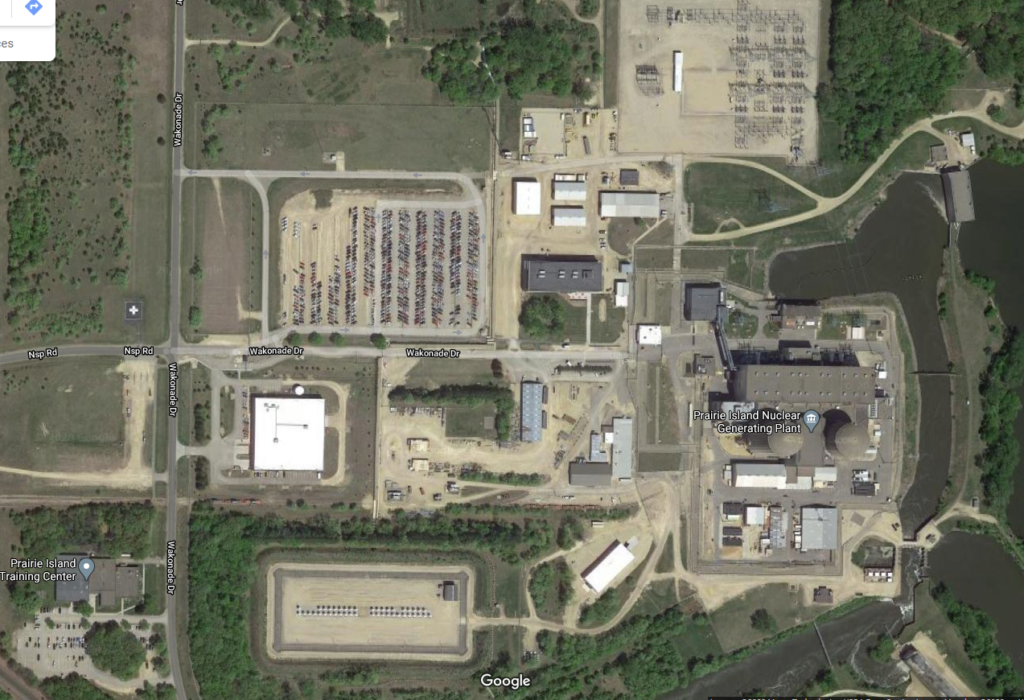
The story of utility personal property tax goes way back in Red Wing, in Goodhue County. When the latest round of tax notices, the 2021 Proposed Tax, were received, people were whining and crying, and when I asked them what they’d do different, NOT A SINGLE SUBSTANTIVE RESPONSE (“cut spending” is not a response, “VETO” is not a response. Let’s get specific here folks, what would you do different??). It also seems that people do not understand the impact of Xcel Energy’s tax cuts and how their cuts are heaped on US regular property owners!
While putting up some articles today that dropped from the heavens into this Legalectric repository, I ran across some old editorials that are a needed history lesson as people in Red Wing discuss property taxes. Red Wing Budget 2021 page! Here in Red Wing, we’re having to make up for the loss of the utility personal property taxes that our “good neighbor” Xcel has weaseled out of over the years. 20+ years ago, starting in 1995 just after NSP succeeded in its fierce lobbying effort to keep the plant open, they pulled the rug out from under Minnesota’s host communities, slashing utility personal property taxes in every way possible. The most recent episode of Xcel Energy cuts was 2018, done in secret at Dept. of Revenue, they gave Goodhue County, Red Wing, and the school district the finger once again.
Here, in chronological order, are those OLD editorials I found in this computer (click on them for a larger view). History matters.
This first one is particularly obnoxious, as Micheletti’s statement (he was then an NSP lobbyist) that utility personal property tax makes our rates higher is outright lie — our electric rates at that time were far lower than almost everywhere in the country!

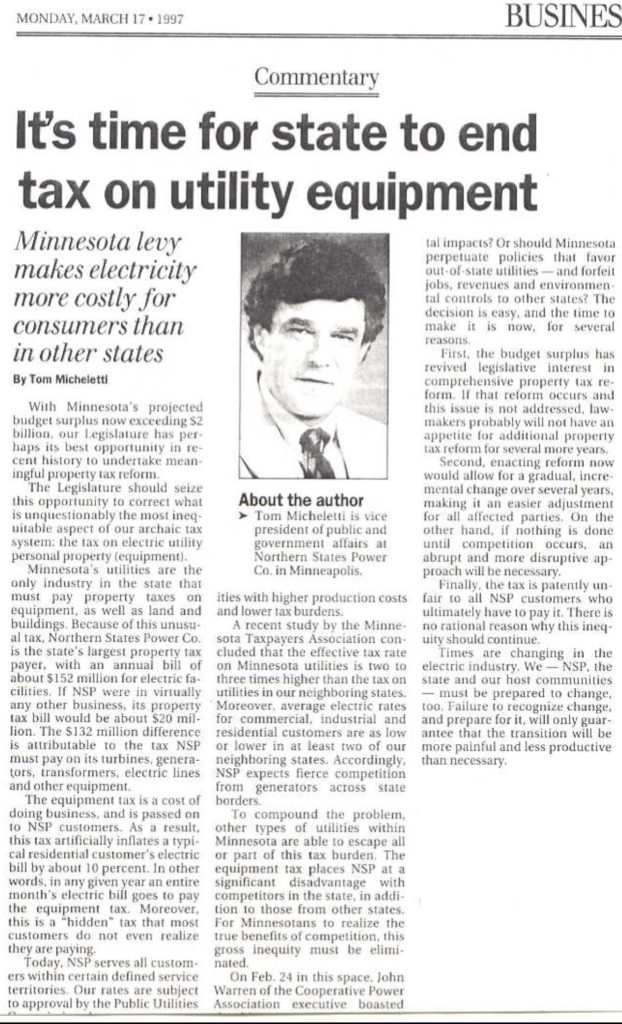

And my take on it, after seeing Micheletti’s push, written because people seem to avoid identifying the root of the problem — Xcel screwing us over — was written just a week later, because Xcel is changing the host deal after the fact. They built the nuclear plant in this host community with an agreement to pay these taxes. Now they pull out of that agreement? I mean really, what are they going to do, take their nuclear plant and go? In 1994, they rallied the troops of Red Wing, Goodhue County, and all other host communities to storm the legislature by the busload “to preserve the tax base” and then starting in 1995, they focus their bigger than ever lobbying presence on eliminating that very same tax base. Yup, that’s how they rewarded their host communities. What a good neighbor. Here’s my response to (then) NSP:
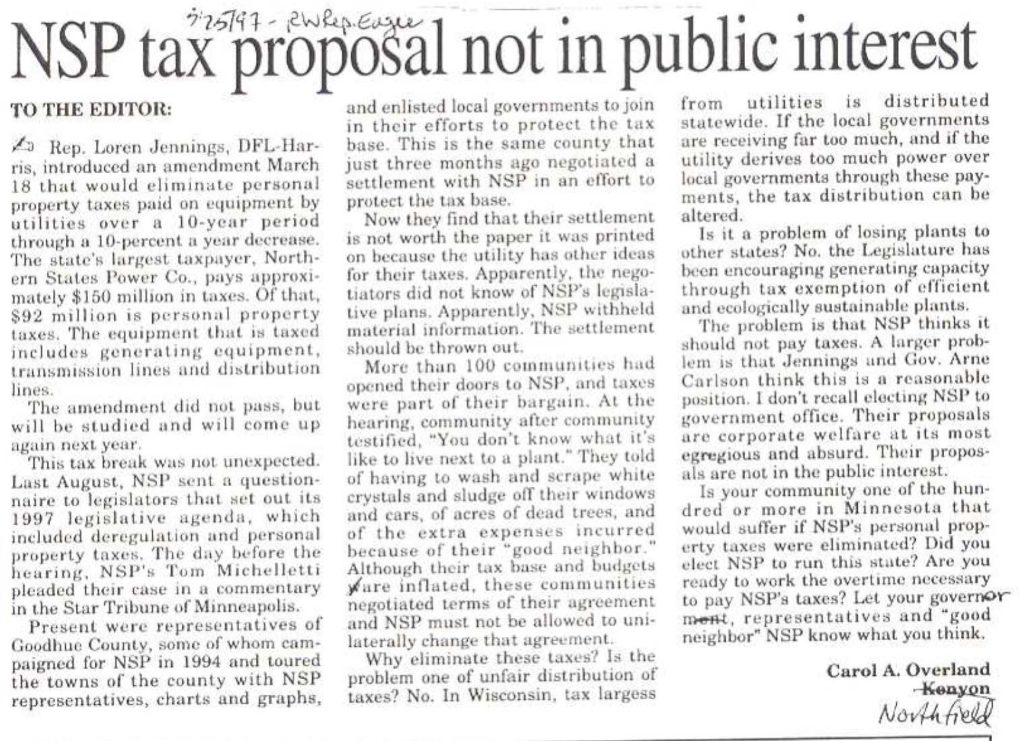
And in the Red Wing Republican Eagle, a heads up to the community, long after NSP/Xcel had started, after the post 1994 taxes were slashed, cut, after NSP/Xcel eliminated so much of the utility personal property tax — and we residents had to take up the difference:
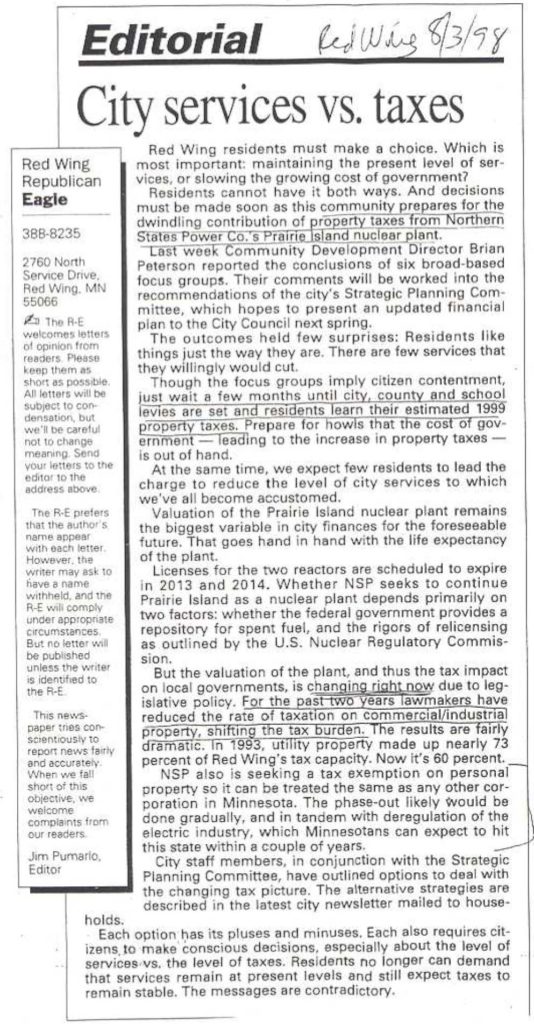
It’s hard to stomach anything from Tom Micheletti, who got his and Julie Jorgensen’s Excelsior Energy Mesaba Project and tens of millions of dollars (DNT Investigation – Excelsior Lobbying Cash Questioned) as a perk in the 2003 Prairie Island bill – Chapter 11, Special Session), with cash flow from state coffers for his bogus idea built into law:




We had to fight that IGCC (coal gasification) Mesaba Project bondoggle for over FOUR YEARS before the Public Utilities Commission finally said NO! Meanwhile, Tom Micheletti and Julie Jorgensen financed by millions from the state’s “Renewable Development Fund,” millions from the Iron Range Resources coffers (Iron Range Resources & IGCC take their lumps), and millions from Department of Energy Grants and Loans, giving him enough to retire in style. “Boondoggle” is too nice a word for that scam.
Ten years and $41 million later, ‘clean coal’ plant still vapor
Is it any wonder I’d holler seeing Julie Jorgensen, Dennis Egan, and Mark Andrews teaming up trying to get a solar project going in Red Wing? AAACK!
Three Musketeers? Three Stooges?
History is important… facts matter!
Nuclear Spent Fuel Storage
December 21st, 2020
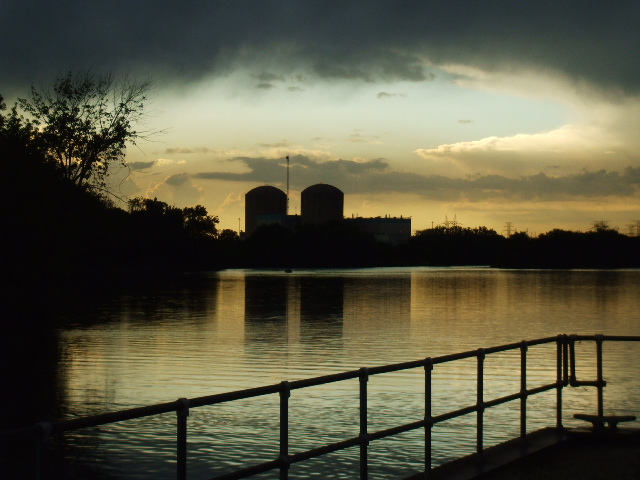
In December, 1994, after the tumultuous legislative session from hell, and the resulting “1994 Prairie Island Bill, Ch. 641, SF 1706,” I noticed a sign up on the window of Kenyon City Hall, looking for someone to represent the City at a Northern States Power (now Xcel Energy) group to “select a site for nuclear waste” somewhere “in Goodhue County,” away from the nuclear plant site. December 14, 1994 was the first meeting of the group, which met over I think 6 months, a most bizarre series of meetings, culminating in NSP’s selection of “Site P” in Florence Township as its preferred site. At that meeting, this truckdriver realized that the seals on the TN-40 casks needed to be replaced. When I asked about that, they had no plan. Oh my, that got my attention — it was clearly not a well thought out plan.

A few nuclear spent fuel documents floated up recently, and here they are:
NUREG-2224 Dry Storage and Transportation of High Burnup Spent Nuclear Fuel

In I think May, 1995, they started filling up casks and putting them on a pad at Prairie Island, and meanwhile, the NSP group’s meetings ended, the Environmental Quality Board formed an official Citizens Advisory Task Force on nuclear waste, with the task of reviewing the NSP application to the EQB for a site permit. The Task Force ended and issued this report:
At that time, I was spending a lot of time learning about casks, paying attention to anything that came up, with particular interest in whether casks could indeed be unloaded.
Trans Nuclear casks were used at Prairie Island, they’re also at Arkansas Nuclear 1, somewhere else to… Here’s a miscellaneous dock from TransNuclear (it has another name now):
Transnuclear Handouts – Part 3 of 6 – 10/07/09 Public Meeting https://www.nrc.gov/docs/ML0927/ML092790437.pdf
Around that time was the “Point Beach Ignition Event” where they left the zinc assembly in the boric acid solution in the cask overnight until the next shift came in, and then tried to weld it. Zinc + boric acid = hydrogen. BOOM! Clue: “Gas ignition event” = EXPLOSION! The cask lid bent up a few inches (it was 9″ thick!!), the wedges holding assembly basket in place blew out onto the floor…
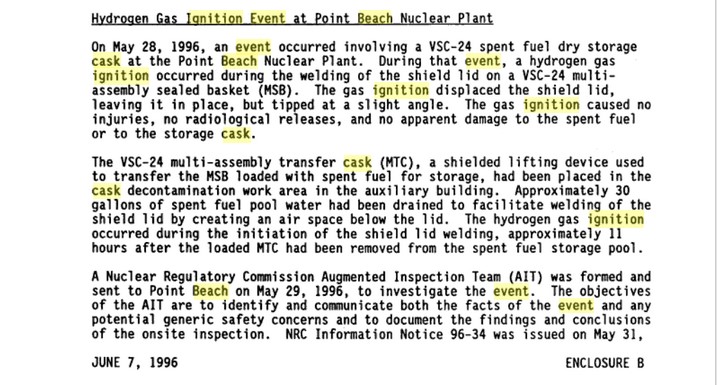

OOPS!
And then there’s the 3 Stooges cask unloading at INEL, this is H-I-L-A-R-I-O-U-S:

Putting this up for future reference – a permanent repository!!!
QAnon game theory
December 16th, 2020

Saw this today and it makes so much sense, but it’s far beyond my ken, perhaps that’s the boomer in me. I’d seen this notion before, A Game Designer’s Analysis Of QAnon, (one notion in this to note Apophenia is : “the tendency to perceive a connection or meaningful pattern between unrelated or random things (such as objects or ideas)” ) but anyway, this Seth Abramson explanation somehow makes more sense, maybe it just took some time to sink in.
I’ve been thinking about this lately as I see people I know spouting such absurd ideas, things jawdroppingly bizarre with no relation to reality, and also seeing that facts don’t matter. QAnon and these bizarre notions considered as gaming and a different reality (well, that different reality was clear early on) explains why “real news” doesn’t matter, why facts don’t matter. Though I doubt tRump is savvy to this, that it’s not intentional on his part, just that he knows this “something” works for him. I think he’s being played by his handlers, his manipulators, and he gets off on it, profits from it.
Food for thought — READ THIS:
A Seth Abramson twitter thread on current alternate reality:
When you misdefine someone as simply an indiscriminate “news consumer” rather than deeming them a LARPer—Live-Action Roleplayer—you erroneously analyze their characteristics and erroneously model their behavior. tRump himself is an ARG—and people enjoy the game too much to stop.
Siting solar? Here’s how!
December 14th, 2020
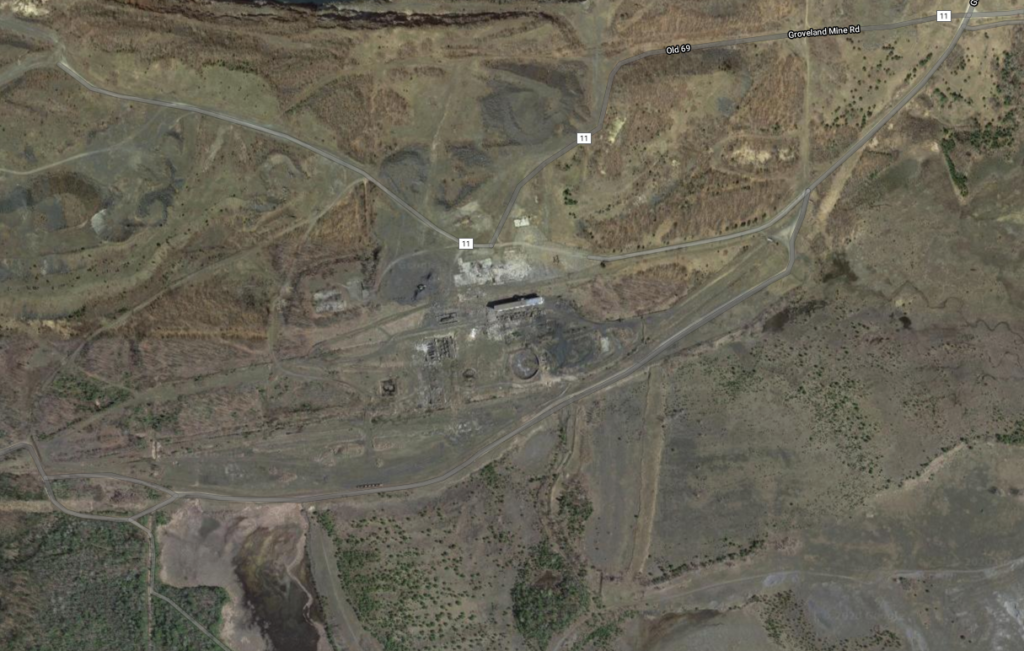
This just appeared, a rational siting notion for a solar project — site it on an abandoned mine site, which because of the prior activity, has transmission ready and waiting. Well, DOH!
A Bright Future: Former U.P. Mine Site to Be Redeveloped as 300-Acre Solar Array
They’re just using a portion of the mine’s land, it could, and SHOULD, be much larger:

Minnesota has a prime ag land exception for power plants:

Wisconsin has a brownfield law, which, at WI’s Public Service Commission permitting deliberation for the Badger Hollow Solar docket, Commissioner said they just ignore that!
Wisconsin brownfield in WI CPCN statute:
https://docs.legis.wisconsin.gov/statutes/statutes/196/491/3/d
(d) Except as provided under par. (e), the commission shall approve an application filed under par. (a) 1. for a certificate of public convenience and necessity only if the commission determines all of the following: … 8. For a large electric generating facility, brownfields, as defined in s. 238.13 (1) (a), are used to the extent practicable.
And the definition of “brownfield” in 238.13 (1) (a):
238.13 Brownfields grant program. (1) In this section: (a) “Brownfields” means abandoned, idle or underused industrial or commercial facilities or sites, the expansion or redevelopment of which is adversely affected by actual or perceived environmental contamination.
****************************************
A Bright Future: Former U.P. Mine Site to Be Redeveloped as 300-Acre Solar Array
By Ben Meyer• Dec 10, 2020 ShareTweetEmail The former Groveland Mine site. In the foreground, concrete foundations and silos are remnants of the processing plant. Beyond them, the tailings areas will serve as land for a new solar array. Credit Dan Dumas/Kim Swisher Communications
On a sunny day last week in Michigan’s Upper Peninsula, Kevin Sundholm picked up a small handful of marble-sized pellets of iron ore from the ground. Pelletized iron ore left over from the days of production at the Groveland Mine. Credit Dan Dumas/Kim Swisher Communications
“Those pellets would go through there and they would get baked,” he said, gesturing at the abandoned foundations of the former Groveland Mine complex near Felch, in Dickinson County.
“You can see the remnants up on top of the silos there,” Sundholm said.
He knows the lay of the land. He worked here more than 40 years ago. Kevin Sundholm, who worked at the Groveland Mine almost 40 years ago. Credit Dan Dumas/Kim Swisher Communications
For decades, the complex produced these pellets from the ore taken from the adjacent open-pit mine. Loads of pellets were taken by train to Escanaba, then by ship to steel mills in Ohio.
“Basically, there [were] 90 to 100 cars of ore pellets that went out of here every day,” Sundholm said. “This place ran 24/7/365. They put out a good [iron ore] pellet, a specialized kind of pellet here that was used in the steel mills.”
But that all ended abruptly in January 1981.
Today, the site is just one of countless decommissioned iron ore mines in the Upper Peninsula.
But the future of the former Groveland Mine is different than the rest.
It’s about to start producing something much cleaner and more modern: solar power.
The state of Michigan hopes Groveland will be one of the first in this trend of redevelopment. The rudimentary mining operations in 1909. Credit Stu Belheumer, from the book Felch Township 1878 to 1978 Centennial
The first small-scale mining started here in 1891, according to Felch Township 1878 to 1978 Centennial, a book edited by Beatrice M. Blomquist.
In the 1950s, the major extraction and shipping of iron ore started.
Kevin Sundholm remembers the exact day he started work at the mine: September 15, 1976.
“At that time, this was the job to have in Dickinson County,” he said. “This job here was the job to have, because of the pay, the benefits, the vacation, just everything. It was the place to work.”
He also remembers the day his supervisor told him he was out of a job, just five years later.
“I said, ‘Oliver, what’s the problem? What’s going on?’ He said, ‘Effective next Friday, this mine will be shut down temporarily.’ Bang. That was a Thursday or Friday. One week later, there she was. They shut her down,” Sundholm said.
The Groveland Mine never reopened. Hundreds of people lost their jobs, and it’s been idle since 1981.
“It was a sad thing. It was a sad, sad thing when it closed,” Sundholm said. “A lot of people lost their livelihood here, and it was a blow to this whole county.” Remnants of infrastructure from the Groveland Mine. Credit Dan Dumas/Kim Swisher Communications
Some of the old mine infrastructure still stands. But the Michigan DNR, which now owns parts of the property, has a new vision for its future, a first-of-its-kind major solar array on DNR land. A map of the area. The circled portion is the target for the solar array. Credit Michigan DNR
“This is kind of a pioneer,” said Matt Fry, a DNR Land Use Program Leader. “Now, we’re talking, with this one, when it’s built out, should be over 300 acres.”
The array will go on the old mine tailings area, a piece of land just southeast of the pit.
The DNR has never tried anything like it on this scale before, but under the direction of Gov. Gretchen Whitmer, the state is being more proactive in developing renewable resources.
“We’re recognizing that we have an issue with climate change,” Fry said. “For the greater good of the citizens of the state, we need electricity.” The tailings area of the Groveland Mine site. The Michigan DNR and Circle Power plan to develop this area into a solar array.
Circle Power is in charge of developing the solar array on the site. The company admits solar in the U.P., where there is sometimes more snow than sun, may seem counterintuitive.
But Jordan Roberts, a Circle Power founder, said advances in the field have made it attractive.
“When we heard this opportunity, and the opportunity to use underutilized land to create a solar project, we got really excited,” he said.
The transition to more solar power will directly help people living locally, according to Roberts.
“In the Upper Peninsula, power costs are quite high,” he said. “There are all sorts of folks looking for ways to get those costs down.”
If the permitting and development go just right, the former mine site could be generating solar power by 2023. It could power 4,000 homes. The open pit at the Groveland Mine. After production stopped, the pit filled with water.
At the site, Kevin Sundholm isn’t the only one with memories of and ties to the mine.
Bob Mattson is Sundholm’s cousin and the Felch Township Supervisor. He’s lived here his entire life.
“It really took off, I think it was 1950 or ’51. That’s when the pellet plant was built. My dad built those silos right there,” Mattson said.
The Township of Felch includes most of the area of the planned solar array.
“I thought it was a great idea. It’s going to create some tax revenue for us, personal property tax, which is a good thing,” Mattson said. These tracks haven’t seen a train full of iron ore in nearly 40 years. But a nearby solar array could be operating by 2023.
Many of Sundholm’s former mine coworkers won’t be around to see the day solar power is generated at the former mine site.
“A lot of the old-timers are gone,” he said.
It’s been nearly forty years since the day the mine closed for good. But, in just a few years, solar panels will start making power for the Upper Peninsula at the very same place.
“I think it’s a great idea,” Sundholm said. “Today it’s sunny. That sun is shining. If those solar panels are out there today, we’re making clean energy.”